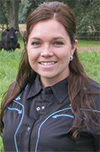While commercial pinkeye vaccines can be very effective at treating common strains, in some cases, it can be economically beneficial to work with a veterinarian and laboratory to develop an autogenous vaccine for your operation.
An autogenous vaccine is, by definition, a vaccine that is prepared from cultures of microorganisms obtained from an individual or population, and then used to immunize that same individual or population against further spread and progress of the same microorganism. In terms of pinkeye in the cattle industry, this translates to taking samples of infected cattle or a herd of cattle, culturing the bacteria and using those pathogens to develop a vaccine that can be used to build immunity within the herd to minimize future outbreaks.
The use of autogenous vaccines to combat pinkeye can be effective, as there are several strains and mutations of the bacteria that are responsible for pinkeye. By culturing bacteria from a particular herd, producers are able to pinpoint the specific strains that are unique to their operation.
Requirements and regulations
Autogenous vaccines are regulated by the USDA and require a script from a veterinarian. Development, distribution and shelf life are all regulated. In addition, if nonadjacent operations (neighbors) would like to work together to create a vaccine, approval from the state veterinarian is required. This is a common practice, and most laboratories are able to assist in the process to gain approval.
Taking swabs
Swab kits can be attained from a lab or veterinarian. It is critical that eyes are swabbed in animals prior to antibiotic treatment. Cattle in early and mid-stages of clinical pinkeye should be sampled. The swabs should be taken from the center of the eye, over the pupil. A total of six to 10 samples should be taken using swabs from the lab that you plan to work with.
Once the vaccine has been created and is being used in the operation, it is recommended that additional swabs are taken whenever there is a new outbreak, especially in situations where new cattle are being introduced on a regular basis.
Other considerations
Depending on the lab you and your veterinarian choose, it typically takes between two to four weeks to receive your first serial of vaccines. The minimum dosage order depends on the laboratory. Typical labs require around 2,000 doses to be ordered; however, there are some that will process much smaller orders. The cost per dose is directly related to the number of doses that are ordered. The approximate cost of a 2,000-dose order would be around $1 to $1.35 per dose, whereas for 5,000 doses the cost would likely be reduced by over 25 cents per dose.
Another tool that works hand-in-hand with autogenous vaccines for pinkeye treatment is an antibiotic sensitivity test. Performed by laboratories, this test will help producers determine which antibiotic treatments will be most effective in treating their particular strains of pinkeye. If working with a laboratory to develop an autogenous pinkeye vaccine, they will likely preform this test. However, for producers who would like to determine which antibiotic would be most effective to treat an outbreak, but don’t plan to develop a vaccine, university and state laboratories are able to perform those tests and cost about $20. This is money well spent when considering the cost of antibiotics and labor to re-treat animals.
Development of autogenous vaccines can be a very cost-effective tool for cattle producers, particularly those working with young and commonly comingled cattle, such as stockers and feedyards. In addition, any operation that struggles with pinkeye, taking advantage of an antibiotic sensitivity test would allow them to ensure they are using the most effective treatment for their operation. As always, working closely with your vet will allow you to maximize the effectiveness of your pinkeye management strategy. ![]()

-
Kalyn Waters
- Agricultural Agent
- University of Florida Extension
- Email Kalyn Waters
PHOTO: Pinkeye costs the beef industry $150 million annually. Photo by Kalyn Waters.








